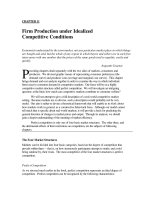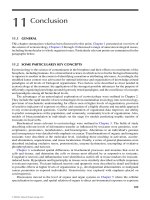Electric commerce chapter 11 e commerce security
Bạn đang xem bản rút gọn của tài liệu. Xem và tải ngay bản đầy đủ của tài liệu tại đây (847.3 KB, 48 trang )
Chapter 11
E-Commerce Security
Learning Objectives
1.
2.
3.
4.
5.
6.
7.
Document the trends in computer and network security
attacks.
Describe the common security practices of businesses of
all sizes.
Understand the basic elements of EC security.
Explain the basic types of network security attacks.
Describe common mistakes that organizations make in
managing security.
Discuss some of the major technologies for securing EC
communications.
Detail some of the major technologies for securing EC
networks components.
Electronic Com
merce
Prentice Hall © 2006
2
The Continuing Need
for E-Commerce Security
Computer Security Institute (CSI)
Nonprofit organization located in San Francisco,
California, that is dedicated to serving and training
information, computer, and network security professionals
Computer Emergency Response Team (CERT)
Group of three teams at Carnegie Mellon University that
monitor the incidence of cyber attacks, analyze
vulnerabilities, and provide guidance on protecting against
attacks
Electronic Com
merce
Prentice Hall © 2006
3
Security Is Everyone’s Business
•
The DHS (Department of Homeland Security)
strategy includes five national priorities:
1. A national cyberspace security response system
2. A national cyberspace security threat and vulnerability
reduction program
3. A national cyberspace security awareness and training
program
4. Securing governments’ cyberspace
5. National security and international security
cooperation
Electronic Com
merce
Prentice Hall © 2006
4
Security Is Everyone’s Business
•
Accomplishing these priorities requires
concerted effort at five levels:
– Level 1—The Home User/Small Business
– Level 2—Large Enterprises
– Level 3—Critical Sectors/Infrastructure
– Level 4—National Issues and Vulnerabilities
– Level 5—Global
Electronic Com
merce
Prentice Hall © 2006
5
Security Is Everyone’s Business
National Cyber Security Division (NCSD)
A division of the Department of Homeland
Security charged with implementing U.S.
cyberspace security strategy
Electronic Com
merce
Prentice Hall © 2006
6
Basic Security Issues
•
What kinds of security questions arise?
–
From the user’s perspective:
• How can the user be sure that the Web server is
owned and operated by a legitimate company?
• How does the user know that the Web page and
form do not contain some malicious or dangerous
code or content?
• How does the user know that the owner of the Web
site will not distribute the information the user
provides to some other party?
Electronic Com
merce
Prentice Hall © 2006
7
Basic Security Issues
•
What kinds of security questions arise?
–
From the company’s perspective:
• How does the company know the user will not
attempt to break into the Web server or alter the
pages and content at the site?
• How does the company know that the user will not
try to disrupt the server so that it is not available to
others?
Electronic Com
merce
Prentice Hall © 2006
8
Basic Security Issues
•
What kinds of security questions arise?
–
From both parties’ perspectives:
• How do both parties know that the network
connection is free from eavesdropping by a third
party “listening” on the line?
• How do they know that the information sent backand-forth between the server and the user’s
browser has not been altered?
Electronic Com
merce
Prentice Hall © 2006
9
Basic Security Issues
authentication
The process by which one entity verifies that another
entity is who he, she, or it claims to be
authorization
The process that ensures that a person has the right
to access certain resources
auditing
The process of collecting information about attempts
to access particular resources, use particular
privileges, or perform other security actions
Electronic Com
merce
Prentice Hall © 2006
10
Exhibit 11.1 General Security Issues at
EC Sites
Electronic Com
merce
Prentice Hall © 2006
11
Types of Threats and Attacks
nontechnical attack
An attack that uses chicanery to trick people into
revealing sensitive information or performing
actions that compromise the security of a
network
Electronic Com
merce
Prentice Hall © 2006
12
Types of Threats and Attacks
•
Nontechnical Attacks: Social Engineering
social engineering
A type of nontechnical attack that uses social
pressures to trick computer users into compromising
computer networks to which those individuals have
access
– A multiprong approach should be used to combat
social engineering
• Education and training
• Policies and procedures
ã Penetration testing
Electronic Com
merce
Prentice Hall â 2006
13
Types of Threats and Attacks
technical attack
An attack perpetrated using software and systems
knowledge or expertise
common (security) vulnerabilities and exposures
(CVEs)
Publicly known computer security risks, which are
collected, listed, and shared by a board of securityrelated organizations (cve.mitre.org)
National Infrastructure Protection Center (NIPC)
A joint partnership under the auspices of the FBI between
governmental and private industry; designed to prevent
and protect the nation’s infrastructure
Electronic Com
merce
Prentice Hall © 2006
14
Types of Threats and Attacks
denial-of-service (DoS) attack
An attack on a Web site in which an attacker uses
specialized software to send a flood of data packets
to the target computer with the aim of overloading
its resources
distributed denial-ofservice (DDoS) attack
A denial-of-service attack in which the attacker
gains illegal administrative access to as many
computers on the Internet as possible and uses the
multiple computers to send a flood of data packets
to the target computer
Electronic Com
merce
Prentice Hall © 2006
15
Exhibit 11.2 Using Zombies in a Distributed
Denial-of-Service Attack
Electronic Com
merce
Prentice Hall © 2006
16
Types of Threats and Attacks
malware
A generic term for malicious software
•
A number of factors have contributed to the overall
increase in malicious code. Among these factors,
the following are paramount:
– Mixing data and executable instructions
– Increasingly homogenous computing
environments
– Unprecedented connectivity
– Larger clueless user base
Electronic Com
merce
Prentice Hall © 2006
17
Types of Threats and Attacks
–
As the number of attacks increases, the following
trends in malicious code are emerging:
• Increased speed and volume of attacks
• Reduced time between the discovery of a vulnerability
and the release of an attack to exploit the vulnerability
• Remotely-controlled bot networks are growing
• E-commerce is the most frequently targeted industry
• Attacks against Web application technologies are
increasing
• A large percent of Fortune 100 companies have been
compromised by worms
Electronic Com
merce
Prentice Hall © 2006
18
Types of Threats and Attacks
virus
A piece of software code that inserts itself into a host,
including the operating systems, in order to propagate; it
requires that its host program be run to activate it
worm
A software program that runs independently, consuming
the resources of its host in order to maintain itself, that is
capable of propagating a complete working version of itself
onto another machine
Electronic Com
merce
Prentice Hall © 2006
19
Managing EC Security
•
Common mistakes in managing security risks:
–
–
–
–
–
Undervalued information
Narrowly defined security boundaries
Reactive security management
Dated security management processes
Lack of communication about security responsibilities
Electronic Com
merce
Prentice Hall © 2006
20
Managing EC Security
•
Security Risk Management
security risk management
A systematic process for determining the likelihood of
various security attacks and for identifying the actions
needed to prevent or mitigate those attacks
–
Security risk management consists of three phases:
• Asset identification
• Risk assessment
• Implementation
Electronic Com
merce
Prentice Hall © 2006
21
Securing EC Communications
access control
Mechanism that determines who can legitimately use
a network resource
passive tokens
Storage devices (e.g., magnetic strips) that contain a
secret code used in a two-factor authentication
system
active tokens
Small, stand-alone electronic devices that generate
one-time passwords used in a two-factor
authentication system
Electronic Com
merce
Prentice Hall © 2006
22
Securing EC Communications
biometric systems
Authentication systems that identify a person by
measurement of a biological characteristic, such as
fingerprints, iris (eye) patterns, facial features, or voice
physiological biometrics
Measurements derived directly from different parts of the
body (e.g., fingerprint, iris, hand, facial characteristics)
behavioral biometrics
Measurements derived from various actions and
indirectly from various body parts (e.g., voice scans or
keystroke monitoring)
Electronic Com
merce
Prentice Hall © 2006
23
Securing EC Communications
fingerprint scanning
Measurement of the discontinuities of a person’s
fingerprint, which are then converted to a set of
numbers that are stored as a template and used to
authenticate identity
iris scanning
Measurement of the unique spots in the iris (colored
part of the eye), which are then converted to a set of
numbers that are stored as a template and used to
authenticate identity
Electronic Com
merce
Prentice Hall © 2006
24
Securing EC Communications
public key infrastructure (PKI)
A scheme for securing e-payments using public key
encryption and various technical components
encryption
The process of scrambling (encrypting) a message in
such a way that it is difficult, expensive, or timeconsuming for an unauthorized person to unscramble
(decrypt) it
plaintext
An unencrypted message in human-readable form
Electronic Com
merce
Prentice Hall © 2006
25









